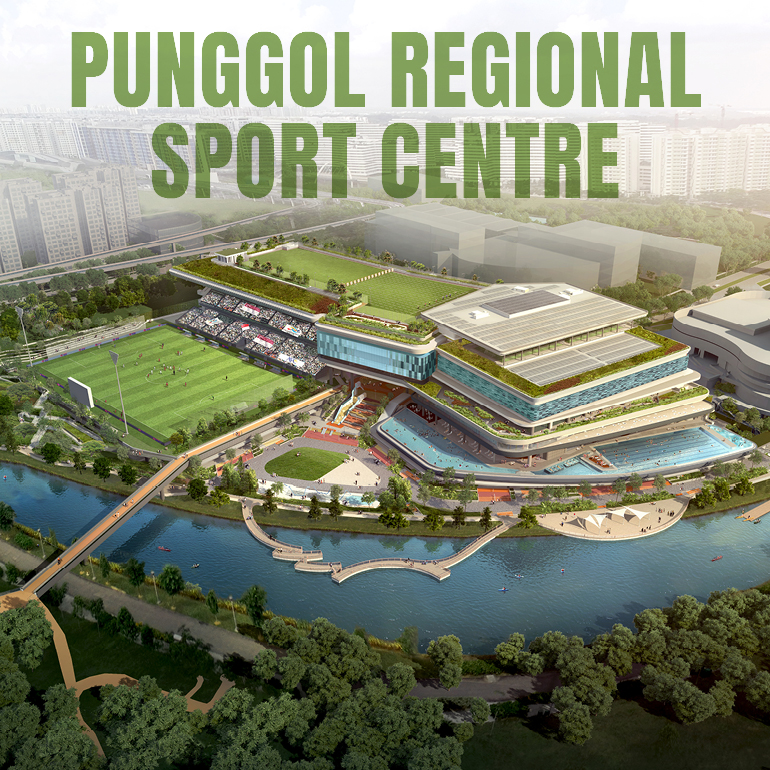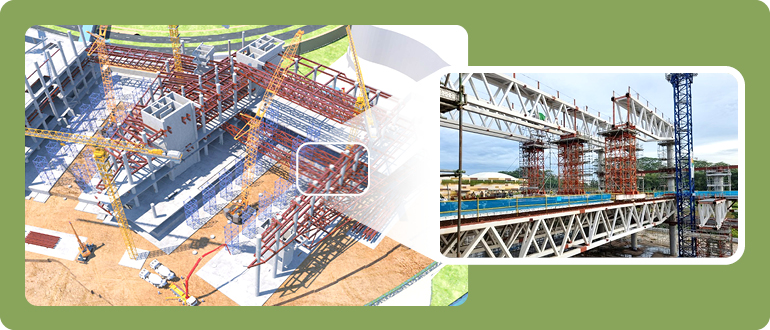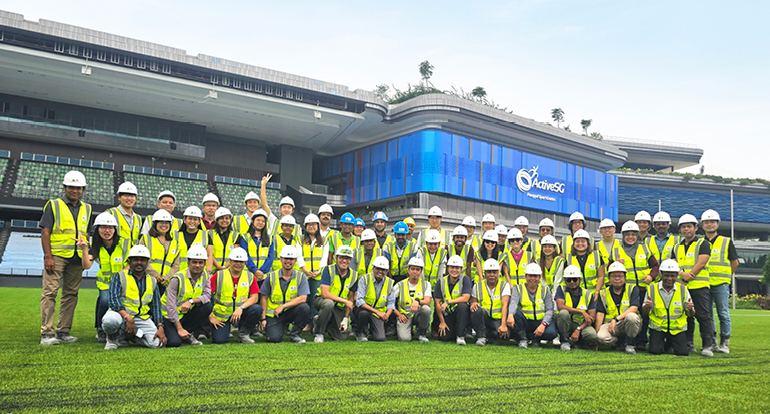
Latest News
- Hyundai E&C Becomes Key Player in the Nuclear Decommissioning Market
- Hyundai E&C Accelerates Global Nuclear Expansion into the U.S. Nuclear Market
- Hyundai E&C Shifts into High Gear to Enter Nordic Large-Scale Nuclear Market
- Hyundai E&C Strengthens Korea-Japan Cooperation in Energy Transition and New Growth Businesses
- Hyundai E&C Signals Green Light for Large-Scale Nuclear Power Plant Business in Europe
A Leader in Sports Venue Construction: Hyundai E&C`s Singapore Punggol Regional Sport Centre

Punggol in Singapore is transforming into a green, smart city, adorned with gleaming shopping malls, stylish residences, and a variety of cutting-edge facilities. The Punggol Regional Sport Centre, slated to open in 2026, is a major cultural and sports complex poised to become a regional landmark and another significant milestone in Singapore's urban development. Let's explore how Hyundai E&C is bringing its innovative technology and exceptional construction expertise to revitalize the Punggol area.
A Sports Landmark Driving a Metropolitan Transformation
A 30-minute drive northeast from the heart of Singapore brings you to Punggol, Singapore's first eco-town and a designated smart city. This approximately 10-square-kilometer area, slightly larger than Seoul's Yeouido, was once an underdeveloped region where most residents were engaged in agriculture and fishing. Designated as a new town in 1996 under the Singapore government's 'Punggol 21' development plan, Punggol accelerated its transformation with the introduction of transportation infrastructure like the above-ground Light Rail Transit (LRT) system.

The Punggol Regional Sport Centre, scheduled for completion this September, will boast a 5,000-seat soccer stadium, in addition to a futsal court, tennis court, archery field, Olympic-size swimming pool and practice pool, indoor sports halls, and a water sports center. Hyundai E&C, leveraging its extensive experience in building various sports venues both in Korea and internationally – including Seoul Sports Complex Baseball Stadium (1982), Incheon Asiad Main Stadium (2014), Stade Olympique Hammadi Agrebi (2001), and King Abdullah Sports City (2014) – secured the Punggol Regional Sport Centre project. This center will act as a sports hub for Singapore and a catalyst for community revitalization. Currently, the project site is focused on the interior and exterior finishing work. To accommodate future international competitions, construction is adhering to a diverse array of international sports certification standards such as FIFA Pro Star and FIBA Competition Level

[ Aerial View of the Punggol Regional Sport Centre ]
The Secret Behind the Massive, Stable Roof
Sports centers need large, open spaces to host diverse sporting activities and other events. Supporting a massive roof without columns requires a specialized structure. This is achieved through the use of 'Mega Trusses.' A mega truss is a large, triangular structure, also employed in bridges and aircraft hangars, that serves as a super-sized framework, supporting the walls and roof of an expansive space with minimal or no columns. For the Punggol Regional Sport Centre, mega trusses, each measuring 55 meters in length and weighing 150 tons, were installed in the swimming pool and tennis court areas.
Transporting the mega trusses to the site presented a considerable challenge. Singapore's traffic regulations prohibit the daytime transport of oversized, heavy loads. It required meeting stringent size and weight criteria and could only be done after midnight, when public transport was no longer in operation, under police escort. The project team opted to pre-assemble the mega trusses, fabricated at a steel factory, to verify the precise manufacturing of each steel component. They were then cut into transportable sections (approximately 25-30m in length) for delivery to the construction site. This meticulously planned operation factored in the route to the site, the turning radius of the transport vehicles, and the clearance height under pedestrian bridges. Special MSPE(Modular Self-Propelled Electric) trailers, commonly used for transporting space shuttles and rockets, were deployed, resulting in 112 dynamic and suspenseful transport operations, akin to scenes from an espionage thriller.

[ Mega Trusses were transported early each morning, escorted by police, using MSPEs ]
The Punggol Regional Sport Centre achieved structural stability through the installation of mega trusses on the 3rd floor, the building's midpoint, and the 6th floor, supporting the upper levels. Typically, mega truss installation involves constructing vertical elements like columns or walls, followed by horizontal elements such as beams and floors, in a sequential manner. The conventional approach is to build up one floor at a time. However, due to insufficient space for crane rotation at the site, the expert construction team meticulously divided the building into three vertical zones (A, B, and C) for construction. Employing a bottom-up construction method, proceeding from the base to the top regardless of floor level but sequentially in zones, they successfully ensured both efficient and high-quality construction.

[ For enhanced construction efficiency, the mega trusses were segmented into zones and installed using a bottom-up approach ]
Precision Design for Peak Athletic Performance
The Punggol Regional Sport Centre not only incorporates sophisticated architectural elements but also meticulously considers system designs, including lighting and ventilation, to enhance the quality of competition.
When watching televised soccer matches, the field consistently appears as bright as day, regardless of the actual match time. Even in slow-motion replays of players kicking the ball, there's no flicker whatsoever. In international soccer competitions, lighting standards are just as rigorous as those for the condition of the turf. While the typical illuminance standard for normal soccer matches is around 500 lux, FIFA's mandated standard for official soccer matches is a significantly higher 2,000 lux.
With the hope of hosting international soccer competitions, Singapore is developing the Punggol Regional Sport Centre to meet the standards required for tournaments like the World Cup and the Olympics. Hyundai E&C carefully selected lighting products and conducted numerous simulations to guarantee not only brightness compliant with international regulations, but also consistent vertical illuminance across all sections of the soccer field.

[ Simulation process for uniform illuminance. The design ensures consistent brightness throughout the entire space, centered on the middle of the stadium ]
Moreover, indoor sports facilities, filled with the heat generated by athletes, necessitate mechanical ventilation. While it might seem straightforward to install air conditioners or air purifiers appropriate for the area, this also demands precise calculations. Consider badminton, for instance. A shuttlecock, crafted from goose feathers, weighs a mere 5.5g. Not only temperature and humidity, but even a slight breeze from an air conditioner can significantly alter the trajectory of the game.
Indeed, a prior badminton match held in China involved specific training to counter strong air conditioner currents within the venue. Hyundai E&C meticulously selected the placement of the Air-Conditioning Mechanical Ventilation(ACMV) system to prevent airflow from air conditioners and ventilation systems from impacting gameplay. Comprehensive verifications, including simulations of air circulation changes based on indoor temperature, were also conducted.
Cultivating a Green Urban Landscape
The Punggol Regional Sport Centre is contributing to Punggol's green urban vision by incorporating water reuse technology. A prime example is the automated irrigation system that utilizes harvested rainwater. Singapore experiences inconsistent rainfall patterns and possesses a limited number of rivers and lakes, leading to extremely low water self-sufficiency. Hyundai E&C implemented an automatic irrigation system at the Punggol Regional Sport Centre, storing rainwater in a dedicated tank and distributing it to landscaping features. A long-term strategy is also in place to utilize NEWater, which is reclaimed from treated sewage, to address Singapore's persistent water scarcity. Concurrently, plans are underway to install solar panels on the roofs of select facilities, like the futsal court, to generate electricity from sustainable energy sources.

[ Staff of Singapore Punggol Regional Sport Centre Site ]
When not hosting competitions, the Singapore Punggol Regional Sport Centre will serve as a vibrant cultural and sports venue for residents' recreational pursuits, injecting energy into the Punggol community. Furthermore, the Singapore government anticipates the center will become a catalyst, stimulating local commerce and tourism and generating positive ripple effects, including job creation. Just like the numerous landmark projects Hyundai E&C has completed in Singapore, the Punggol Regional Sport Centre will stand as another strong testament to Hyundai E&C's experience and technological capabilities in the global market.
|
“The Punggol Regional Sport Centre will serve as a vital cornerstone, fostering positive synergies for future projects across Singapore. We are committed to collaborating closely with the client and consultants to achieve our goal of opening in 2026.” Hyun-sik Choo, Project Director, Singapore Punggol Regional Sport Centre Site
“The smooth progress of this project is a testament to the dedication of many different individuals. I'd like to express my sincere gratitude to former Project Director Dong-hyun Lee and Chang-og Kang, Senior Managers Hyun-heum Hwang, Sang-hyun Kim, Chang-eun Yu, Ho-young Kwak, Seong-hyoek Hwang, Jae-chul Shin, Sang-yun Han, and Oh-uk Kwon, along with Managers Baek-jin Gil and Jenie Jin, who all contributed to the project’s success. I also extend my encouragement to all the current staff members, urging them to persevere until the project's completion.” Hong-kyu Kim, Project Support Team Leader, Singapore Punggol Regional Sport Centre Site |

